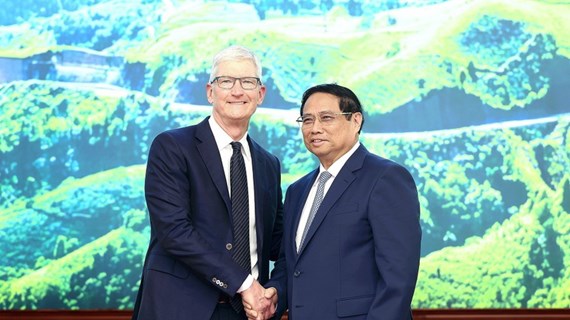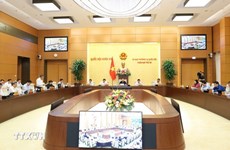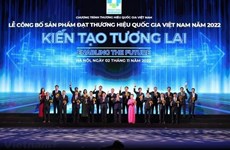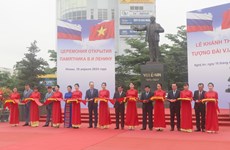Mexican artist finds new inspirations in Vietnam
Mexican contemporary artist Roberto Arcaute has chosen Vietnam as the final destination in his journey to finish his latest installation project.
 Artist Roberto Arcuate collects waste such as plastic pipes and gives them a new life in the form of porcelain sculptures. (Photo: VNS/VNA)
Artist Roberto Arcuate collects waste such as plastic pipes and gives them a new life in the form of porcelain sculptures. (Photo: VNS/VNA)The project, named Union: Narrations of a Civilisation, aims to convey a message about the environment. Its idea is to take and copy everyday waste objects and reproduce them in porcelain sculptures with all their labelling information in blue.
It will feature nine sculptures generated from different waste that the artist has selected. Three sculptures are based on the selection of domestic waste that is normally generated in the home like paper, glass, plastic bottles; three others are based on the selection of urban waste that is normally generated in areas where people coexist and the rest on based on the selection of commercial waste from offices, restaurants, and stores, usually food, paper, or cardboard.
In the later phase of the project, he intends to select some of the finished objects to create a form of conglomerate type mass with the help of clay, cement and oven heat.
He said: “The word UNION in this project refers to something obtained by conglomeration (gathering, piling up, and joining fragments). The project proposes to show how a narrative of a consumer society is constructed and how its waste can be reincorporated into our civilisation from reproductions of itself.”
The 46-year-old artist has pursued Union: Narrations of a Civilisation for five years under the sponsorship of the Mexican government. He conducted parts of his project in Mexico, the US, China and several others before coming to Vietnam.
He first came to the country eight years ago as a tourist and had the opportunity to have first-hand experience of local culture. He was particularly impressed with Vietnamese handmade pottery due to its sophistication and uniqueness and decided to finalise his installation project in the Bat Trang ceramic village on his second visit.
He added: “Vietnam has a culture similar to other countries in the region but also has its own identity and pottery is an example. The clay in Bat Trang village is different from the places I've been to. In addition, a most striking feature in each product is the craftsmanship.
“I have travelled to Jingdezhen town, the ceramic capital of China. But I was still impressed on how meticulous it takes for each Bat Trang artisan to create the best version of their works. They don't focus on mass production.
“It has been a great adventure to have this visual experience. I think Bat Trang is becoming famous in the world and soon we will hear much more about this wonderful area of Vietnam.”
It took him a while to find the appropriate pottery workshop and kiln. Eventually he found one that could provide him with English-speaking assistants and a space to work without affecting its daily production.
It didn’t take him long to get accustomed to his new life and discover more exciting aspects from the simple things of city life.
Every day, the Mexican artist drives his motorbike from his apartment in the centre of Hanoi to Bat Trang village, about 10km away. Possessing an international driver's license, driving a motorbike has caused him no difficulties, unlike many other foreigners who might feel afraid of heavy traffic in the capital city.
“I leave home early in the morning and return at sunset," he said. "Along the way, I always hear very special sounds. People say it's the sound of summer cicadas. It was the first time in my life that I heard such sounds.
“Another interesting thing is that Hanoi has a lot of rivers and lakes and it rains frequently this season. I find the climate here wonderful. My hometown is in Monterrey, a dry area with many deserts, hills and having no natural water source, so when I saw Hanoi with many rivers and lakes, I was extremely excited. Whenever crossing the Red River, I often try to slow down to enjoy the view.
“The most important wealth is the kindness of every person and also the spirit of work that could be seen everyday. Without a doubt, that makes Vietnam different from other countries.”
Arcaute has also been collaborating with the Mexican Embassy in Vietnam to conduct a series of art activities, like a conference at the Vietnam University of Fine Arts.
“I feel very lucky because it is not easy to win such art support in my country,” he said.
Arcaute plans to have Union: Narrations of a Civilisation exhibited in both Mexico and Vietnam next year, and at the same time, publish a book describing the entire project in four languages: Spanish, English, Chinese and Vietnamese.
The Mexican artist also revealed that he would like to travel to Ho Chi Minh City, Da Nang and several other destinations during his next visit to explore the native culture, which might inspire him with his future works./.













